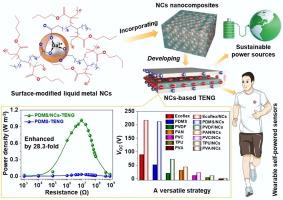Surface-modified liquid metal nanocapsules derived multiple triboelectric composites for efficient energy harvesting and wearable self-powered sensing
Abstract
Liquid metal (LM) has been widely used as flexible electrodes for triboelectric nanogenerators (TENGs). However, the development of high-performance triboelectric composites based on LM droplets is still challenging due to the mismatched surface tension. Here, copolymer surface-modified LM nanocapsules (CPLM NCs) with core–shell structure are successfully synthesized via two-step method containing chelation reaction and in situ free-radical polymerization. The as-synthesized NCs can be incorporated into various polymers to fabricate diverse flexible polymer/NCs nanocomposites. Based on surface engineering, CPLM will not leak and drop off from nanocomposites when they suffer severe deformations, exhibiting good interfacial compatibility and robust mechanical properties. The introduction of NCs can improve the charge storage capability and electric outputs of various nanocomposites owing to more interfacial polarization sites, showing a versatile strategy for manufacturing high-powered triboelectric composites. The optimized polydimethylsiloxane/NCs-based TENG (PDMS/NCs-TENG) delivers a significant enhancement of power density by 28.3-fold and can availably power wearable electronics. PDMS/NCs-TENG can be also developed as a wearable self-powered sensor to detect physiological signals and joint-related motions in a real-time, rapid, and noninvasive way. This work not only renders a versatile strategy for the development of high-performance triboelectric materials but also provides a sustainable energy solution for wearable electronics.


 求助内容:
求助内容: 应助结果提醒方式:
应助结果提醒方式:


